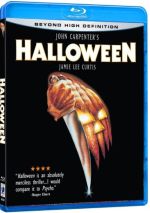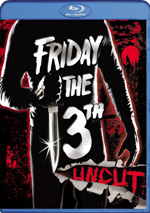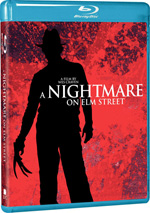|
ANCHOR BAY
|

| |
|
MOVIE INFO
|
|
Director:
John Carpenter
Cast:
Jamie Lee Curtis, Donald Pleasence, Nancy Kyes, P.J. Soles, Charles Cyphers, Kyle Richards, Brian Andrews, John Michael Graham
Writing Credits:
John Carpenter, Debra Hill
Tagline:
The Night HE Came Home!
Synopsis:
On Halloween night of 1963, 6-year old Michael Myers stabbed his sister to death. After sitting in a mental hospital for 15 years, Myers escapes and returns to Haddonfield to kill.
Box Office:
Budget $325 thousand.
Domestic Gross
$47.000 million.
MPAA:
Rated R
| |
|
DISC DETAILS
|
Presentation:
Aspect Ratio: 2.35:1
Audio:
English Dolby Digital 5.1
English Uncompressed PCM 5.1
English Monaural
Subtitles:
English
Closed-captioned
Supplements Subtitles:
None
Runtime: 91 min.
Price: $29.98
Release Date: 10/2/2007
Bonus:
• Audio Commentary by Writer/Director John Carpenter, Writer/Producer Debra Hill, and Actor Jamie Lee Curtis
• “Fast Film Facts” Subtitle Commentary
• “A Cut Above the Rest” Documentary
• Theatrical Trailer
• TV Spots
• Radio Spots
| |
|
PURCHASE @ AMAZON.COM
|

| |
|
EQUIPMENT
|
Panasonic TC-P60VT60 60-Inch 1080p 600Hz 3D Smart Plasma HDTV; Sony STR-DG1200 7.1 Channel Receiver; Panasonic DMP-BD60K Blu-Ray Player using HDMI outputs; Michael Green Revolution Cinema 6i Speakers (all five); Kenwood 1050SW 150-watt Subwoofer.
| |
|
RELATED REVIEWS
|


| |
|
Halloween [Blu-Ray] (1978)
|
|
Reviewed by Colin Jacobson (January 13, 2016)
Would we still have witnessed the explosion of "slasher" movies during the late 1970s and early 1980s if 1978's Halloween never existed? Probably not.
That creates a muddled legacy, as for every good horror movie of that era, there were about ten terrible ones, including the sequels to Halloween. However, the high quality of the original cannot be disputed. Almost 40 years later, Halloween remains one of the all-time great horror films.
In a prologue set on Halloween, 1963, young Michael Myers (Will Sandin) uses a big kitchen knife to stab his sister Judith (Sandy Johnson) to death. He ends up placed in a mental institution, and 15 years later, an adult Michael (Nick Castle) escapes. Supervising psychiatrist Dr. Sam Loomis (Donald Pleasence) immediately fears the worst and does his best to track Michael before the maniac kills again.
This takes him Michael’s hometown of Haddonfield, where we meet Laurie Strode (Jamie Leigh Curtis), a sweet, innocent high school senior. She feels like some stalks her, but her pals dismiss this notion. We follow Michael’s visit to Haddonfield as well as its violent impact on Laurie and her friends.
This film is a textbook study in how to create an effective thriller and it mostly makes all of the right moves. It starts out slowly, builds with a number of well-timed scares, and ends with a truly climatic showdown.
Actually, Halloween presents a bunch of climactic showdowns, since villain Michael Myers foreshadowed the Energizer bunny by a number of years with his refusal to stay dead. That's one of the many soon-to-be conventions of the genre that appear in Halloween. The unstoppable killer, the virginal heroine, the multiple endings - you name it, it's here. One difference is that they weren't clichés where they appeared here.
Another contrast between Halloween and most of the subsequent genre films stems from the style and panache that John Carpenter's direction brought to it. He moves the film along effectively and tries not to waste the viewer's time; there's just enough exposition to set the stage, but not too much to bog down the audience.
I also really like the way that he uses the camera and the full width of the widescreen frame. Carpenter tends to keep the camera at something of a distance from its subjects, and he also frequently uses steadicam. These two factors combine to give the film an effective "voyeuristic" feel, like we're viewing these events ourselves from a slightly-removed vantage point.
Carpenter's minimalist score also seems excellent. Throughout the film, we only hear simple piano with some synthesizer intermixed. It probably shouldn’t work, but it does. Carpenter's eerie piano ranks up there with the shrieking violins of Psycho as some of the all-time best horror movie music.
The acting in Halloween is a cut above the horror movie norm, though that isn't saying much. Jamie Lee Curtis easily outshines the rest of the cast. Her turn as heroine Laurie Strode is simple, natural and honest, with none of the annoying histrionics one frequently encounters in this kind of role.
As foreboding psychiatrist Dr. Sam Loomis, Donald Pleasence does pretty well, but I think he's hampered by some of the corny lines he has to speak – could anyone say "the evil is gone!" with a straight face? Also, his character really doesn't do much, as he's largely there for expository reasons, and Pleasence makes do the best he can.
As Laurie’s slutty teen friends, both PJ Soles and Nancy Loomis round out the main cast, and they do so with rather unspectacular performances. Loomis seems wooden and artificial, while Soles errs on the opposite end of the spectrum; she serves her role with too much energy and exuberance.
I wonder if perhaps these parts were played somewhat poorly on purpose, since the artificiality of these characters contrasts so strongly with the down-to-earth nature of Laurie. Whether intentional or not, I don't find that the somewhat substandard acting harmed the film.
A genuine classic, Halloween revitalized a genre and created a zillion imitators. Despite that dubious legacy, the movie remains a solid piece of work. It presents a chilling tale that avoids the easy gore and excesses of later efforts. It’s a fine film.
|
The Disc Grades: Picture B-/ Audio B/ Bonus B
|
|
Halloween appears in an aspect ratio of approximately 2.35:1 on this Blu-ray Disc. On a superficial basis, the disc looked good, but I thought it suffered from some deeper problems.
My primary concern stemmed from the apparent use of digital noise reduction. A lot of shots had a “smoothed-out” look that simply didn’t seem natural.
This became most apparent in the nighttime segment with Dr. Loomis and the nurse – that sequence took on an odd “videotape” feel – but other shots seemed to lack a film-like appearance as well. Facial textures also looked a bit “plastic”. This wasn’t a terrible concern, but it gave the movie a look that just didn’t feel right.
Otherwise, the image seemed satisfactory. Sharpness mainly appeared positive, as the movie usually offered tight, concise elements. Some softness crept into wide shots at times, but not to a substantial degree. I noticed no edge haloes or jaggies, and moiré effects remained absent. A clean image, the movie seemed to lack print flaws.
As was the case with a prior DVD, the Blu-ray’s color palette has come under protest, as fans indicate it may not represent the look of the original. I thought the hues looked fine – the movie didn’t get some modern-style tint – and came across well. Blacks were dark and deep, and low-light shots offered generally positive delineation. I’d like a more film-like appearance for Halloween, but it still seemed mostly positive.
Remixed from the original monaural material – which also appeared here - the Uncompressed PCM 5.1 audio seemed surprisingly robust. Many of these 5.1 remixes fare poorly, but I thought the one for Halloween appeared natural and well done.
The soundfield offered a good sense of atmosphere. John Carpenter’s score worked really nicely, as it showed fine stereo imaging. The track didn’t go nuts with effects, but it created a solid feeling of place. A little directional dialogue added to the presentation at times.
Some elements panned smoothly across the front channels, and the surrounds kicked in occasionally. The disc's "demo" moment came during a thunderstorm in chapter 3, a moment when the sound genuinely heightened the tension in the scene. Most of the other sequences were more subdued, but they contributed a decent sense of atmosphere nonetheless.
Overall, I found the actual quality of the audio to also be surprisingly strong. Speech was distinct and natural and suffered from no signs of edginess or issues connected to intelligibility. At times the effects sounded a little flat and artificial, but those issues occurred infrequently, and they avoided the harshness and the tinny quality that frequently accompanies these older efforts.
The score remained the track’s strongest element, as the music seemed rich and full at all times. The only negative I attached to this mix came from a mild hum that emanated from my LFE channel at times. This didn’t seem strong, but it became a bit of a distraction. Even with that issue, though, this was a pretty good soundtrack.
How does the Blu-ray compare to the 2003 25th Anniversary DVD? Audio was a bit bolder, though it introduced the light hum I mentioned. Visuals appeared sharper and clearer, so even with the smoothed-out feel, this was still a step-up over the DVD.
Many of the 2003 DVD’s extras repeat here, and these include an audio commentary from writer/director John Carpenter, writer/producer Debra Hill, and actor Jamie Lee Curtis. All three recorded individual running, screen-specific tracks that were then edited together for this piece. The commentary originally was created for a Criterion laserdisc that came out in the mid-Nineties.
While not one of Criterion’s absolute best efforts, the Halloween track works pretty well. The commentary covers a variety of topics. We learn about the project’s genesis and formative stages as well as issues related to its creation. The participants go over a few technical topics plus some creative concerns and influences.
They also get into genre-wide issues and chat about the movie’s influence and legacy. No one speaker dominates, as the track seems pretty evenly spread among the three. At times Carpenter does little more than narrate the film, but that doesn’t occur often, and this remains a pretty entertaining and informative discussion.
New to the Blu-ray, Film Fast Facts provides a subtitle commentary. It gives us basics about the production, cast and crew. Most of this material appears elsewhere and the “Facts” show up pretty infrequently, so the subtitle track doesn’t add much.
Next we find a documentary called Halloween: A Cut Above the Rest. This one-hour, 27-minute and seven-second program combines movie snippets, archival materials and footage from the set, and interviews. In the latter category, we hear from Carpenter, Hill, Curtis, actors PJ Soles, Charles Cyphers, and Nick Castle, Fangoria Magazine editor Tony Timpone, Compass International Pictures CEO Joseph Wolf, executive producers Irwin Yablans and Moustapha Akaad, production designer/co-editor Tommy Lee Wallace, and director of photography Dean Cundey.
”Cut” goes over the standard progression. It starts with the project’s origins and leads us through casting. From there we learn a lot about the production itself, and the show then moves to the flick’s reception and success.
The remaining parts of the program discuss Halloween’s legacy and subsequent success for its participants as well as its sequels. We already know a lot of the information from the audio commentary, but the package also includes much new material, and it communicates a clear and well-depicted examination of its subject. “Cut” presents too many extended movie clips, but overall, it’s a good documentary.
Halloween also includes some promotional materials. We find the film’s original theatrical trailer along with three TV Spots and three Radio Spots.
What does the Blu-ray lose from the 2003 DVD? It drops one 10-minute featurette as well as a still gallery and some talent bios. None of these become terrible omissions.
One of the most influential movies of any genre, Halloween still holds up well after almost 40 years. The Blu-ray offered erratic but generally good picture as well as a pleasing 5.1 remix and a few informative bonus materials. This doesn’t stand as the definitive Halloween, but it’s mostly satisfactory.
To rate this film, visit the DVD review of HALLOWEEN
|
|

